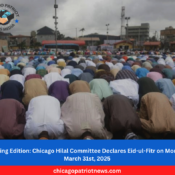Chicago – March 30, 2025
The “First Indian freedom struggle” was organized and led by Moulavi Ahamadullah Shah. Ashfaqulla Khan, who was the first person to be hanged at the age of 27 for plotting against the British Raj. Shah Nawaz Khan served in the Indian National Army (INA) as a Chief Officer and Commander in addition to being a politician.
Maulana Barkatullah Bhopali
With the aid of Turkey and Germany, Maulana Barkatullah Bhopali was able to travel to Kabul in 1915 to join the Ghadar surge against the British that was still going on there. While there, he developed new plans for the conflict to liberate India. Maulana Barkatullah passed away on September 20, 1927, the final night of his life. He spoke to his companions in his final night of life, he told: “I have been striving for the freedom of my motherland with honesty all my life. And today, when I leave this life, where I regret that in my life, my attempt to free the country from British rule could not be successful. But I am also aware of the fact that millions of brave men have come forward after me to free my country, who are honest, brave and even more courageous. Now I am going with a leisurely hand, handing over the fate of my beloved country to their hands.”
Yusuf Meherally
In 1938, Yusuf Meherally served as the head of the Indian delegation to the World Youth Congress in New York before traveling to Mexico for the World Cultural Conference. He wrote the ‘Leaders of India’ book series, a collection of current affairs-related works that he also translated into Gujarati, Hindi, and Urdu. The Working Committee of the INC convened at Wardha on July 14 and agreed to call for total independence. Gandhiji liked the short phrase “Quit India,” which was created by Yusuf Meherally. Yusuf Meherally passed away on July 2, 1950.
Hasrat Mohani
He joined the revolutionary activities while still in college, which forced him to serve time in prison in 1903. Even though he was expelled from college, his quest for freedom was unwavering. He began publishing the ‘Urdu-e-Mualla’ journal from Aligarh in 1903. This publication offered articles that were critical of British rule’s tyranny and flawed policies. With tremendous impunity, Maulana continued on spreading awareness of the independence movement through his writing. He had to enter prison once more as a result in 1907. The British were aware of his writing’s influence. His publication was closed due to the fear of his towering influence. He was one of the Congressmen who was involved. He stayed on staff with the Congress until 1907. Soon after Bal Gangadhar Tilak left the Congress, Maulana followed suit.
Female Muslim Freedom Fighters
Begum Hazrat Mahal
The British exiled Wajid Ali Shah, the Nawab of Avadh, to Bengal, where he married Begum Hazrat Mahal. After her husband was exiled, Begum assumed control of Avadh as the regent and was influential in the 1857 uprising. Like Rani Lakshmi Bai, she protested British control and was particularly against their policy of destroying holy sites. She was offered luxurious accommodations and a sizable sum of money by the British overlords in exchange for her return to Lucknow. Begum, however, rejected them and made it clear that the Independent Awadh state was the only option that she would accept. Till her last breath, Begum Hazarath Mahal fought for the independence of her homeland. On April 7, 1879, she passed away in Kathmandu, Nepal.
Bi Amma
Arguably the first lady to speak at a political gathering while wearing a burqa was Abadi Bano Begum. She participated in national freedom fights, and the Khilafat Movement, and promoted harmony between Hindus and Muslims. She is known as Bi Amma. Bi Amma played a crucial role in persuading women to participate in the fight for liberation on the advice of Mahatma Gandhi. Additionally, she was crucial to the Swadeshi movements. She planned meetings, raised money, and taught women the value of adopting Swadeshi items instead of British ones. Bi Amma worked on this campaign with Begum Hasrat Mohani, Sarala Devi Chaudhurani, Basanti Devi, and Sarojini Naidu. Further, Bi Amma reared Muhammad Ali Jauhar and Shaukat Ali, better known as the Ali Brothers, on her alone after becoming a young widow. When Abadi Bano Begum passed away in 1924, she left a lasting impression on the minds of Indians of all ages. Even the government of Pakistan recognized her contribution to the freedom movement sixty-six years after her passing by creating a commemorative postage stamp in her honor.
Amjadi Begum
was Bi Amma’s daughter-in-law as well as the wife of Muhammad Ali Jauhar. Begum was always urged to enter politics by Bi Amma. Along with her mother-in-law and husband, she actively participated in the national independence movement. She attended all the political gatherings with her husband and even spoke at one to encourage women to take part in the fight for liberation. She allegedly sat next to Ali Jauhar during the First Round Table Conference in London since he couldn’t have survived by himself. She supported her mother-in-law’s involvement in the Khilafat and liberation campaigns. Additionally, on Jinnah’s recommendation, Begum became the only female member of the Muslim League’s First Working Committee, which included 25 men.
Asghari Begum, Habiba and Suraiya Taiyabji
Asghari Begum was about 45 years old at the time of the Revolt and was born in 1811. She is reported to have been a key player in the war against the British in today’s western Uttar Pradesh. In 1858, the British allegedly kidnapped her and burnt her alive.
In the 1857 uprising, Habiba was the one who opposed British rule. She fought numerous battles against the British in Muzaffarnagar and was a Muslim Gujjar. However, at the age of 25, she and 11 other female soldiers were kidnapped and hanged.
Sir Akbar Hydari’s niece, Suraiyya, was born in 1919 and served as the Seventh Nizam’s prime minister from 1937 to 1942. She was a well-known artist who was renowned for her outlandish and forward-thinking viewpoints. She and her husband, an Indian civil servant named Badruddin Tyabji, served on committees in the constituent parliament. She was in fact responsible for creating India’s flag.
Conclusion
India is a free country because of freedom fighters. All Indians must remember their sacrifices and work to maintain social fairness while coexisting in peace and harmony. The legends of freedom fighters continue to inspire today’s children. Their hardships demonstrate the differences in life and the importance of the values they battled for. By fostering peace in the nation, Indian citizens should acknowledge and honor the sacrifice. Without mentioning freedom fighters, patriotism is nothing but a game. Because of freedom fighters, India is independent. Indian Muslim engagement in the independence struggle was very pivotal, hence freedom is etched in their very being.






